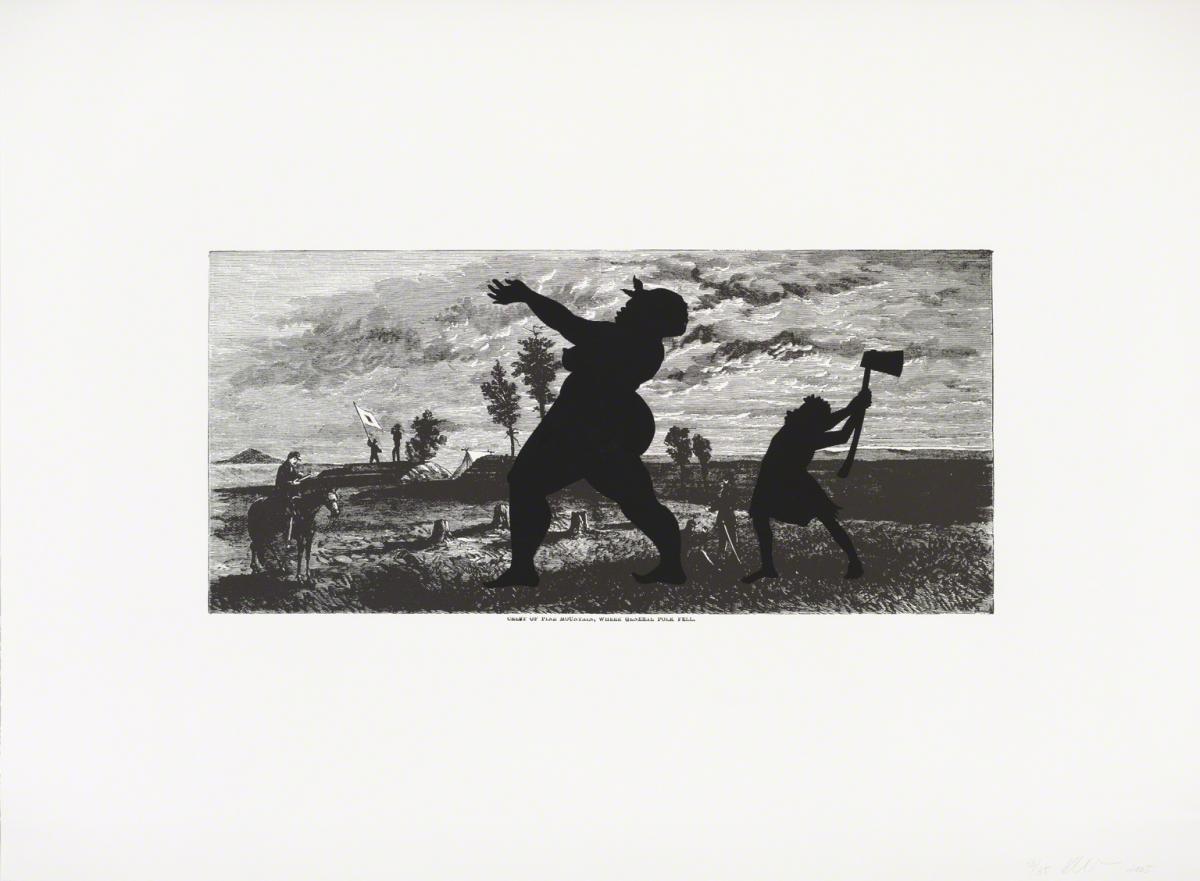Crest of Pine Mountain, where General Polk Fell
Kara Walker ( 2005 )

Like all of Kara Walker’s creative work, Crest of Pine Mountain, where General Polk Fell is a form of truth telling, a vehicle through which she calls out and dispels myths and misrepresentations of our shared past. The print is one of fifteen lithographs and silkscreen prints that comprise her 2005 series Harper’s Pictorial History of the Civil War (Annotated). Interjecting new meaning into the images that illustrated the original two-volume book published in 1866, Walker’s annotated version weaves past and present, myth and fantasy. Each image is the result of a two-part process: first through offset lithography, Walker creates an enlarged print of a given woodcut plate in Harper’s book; then, onto its surface, she overlays silhouetted figures rendered in solid black silkscreen.
The Civil War was not a new subject for Walker. In 1994, she produced her first wall-sized installation, Gone: An Historical Romance of a Civil War as It Occurred b’tween the Dusky Thighs of One Young Negress and Her Heart . Unlike the complacent views of happy, ignorant slaves in the antebellum South perpetuated by Margaret Mitchell’s novel Gone with the Wind (1936), on which her installation was partially based, Walker portrayed the brutality, sexual assaults, and suffering the enslaved people endured at the hands of their white owners.
In returning to the subject of the Civil War, this time in print form, Walker marshalled her signature silhouetted figures to infiltrate one of its first comprehensive primary accounts. In doing so, she challenged the editors’ claim that the 836-page text illustrated with one thousand images represented an “impartial” view that sought to “narrate events just as they occurred.” Catering to its predominantly white readership, the images glorified the heroic battle scenes and rarely showed the presence of the slaves.
In Crest of Pine Mountain, where General Polk Fell , Walker reimagines the original scene from Harper’s publication depicting a decisive moment in the war’s Atlanta campaign, when the Confederate Lieutenant General Leonidas Polk was killed by a cannon ball during a skirmish with Union forces in June 1864. By inserting two forceful female Black figures into the foreground of a landscape laced with shadows of human destruction, Walker gives voice to the suppressed undercurrent of slavery lurking on the political battleground. Walker’s female figures push the white-dominant narrative off center, forcing the viewer to “uncover the often subtle and uncomfortable ways racism, and racist and sexist stereotypes influence and script our everyday lives.” [1] Layering is built into Walker’s physical act of making each image and becomes a metaphor for the buried truths in front of our own eyes waiting to be excavated from the deeply encrusted strata of our changing world.1. Walker, interviewed by Hans Ulrich Obrist, in Kara Walker: Safety Curtain 1998/99, exh. cat. (Vienna: Art Pool, Museum-in-Progress, and Vienna State Opera, 1998), cited in Darby English, How to See a Work of Art in Total Darkness (Cambridge, MA: MIT Press, 2010), 85, n. 17.
Text by Elsa Smithgall, adapted from Seeing Differently: The Phillips Collects for a New Century (The Phillips Collection in association with Giles, 2021)